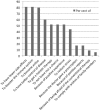Online survey of patients with breast cancer on complementary and alternative medicine
- PMID: 24803889
- PMCID: PMC3995381
- DOI: 10.1159/000360381
Online survey of patients with breast cancer on complementary and alternative medicine
Abstract
About 50% of cancer patients use complementary and alternative medicine (CAM). Women with breast cancer use CAM more frequently than others. We linked a questionnaire to the largest internet portal for cancer patients in Germany. The questionnaire addresses attitude towards CAM, disclosure to the oncologist, source of information, and objectives for use of CAM. 80 patients with breast cancer took part in our study, 61 currently using CAM. Most frequently used CAM methods were selenium, relaxation techniques, prayer, vitamin C, and meditation. Satisfaction was highest with relaxation techniques, vitamin C, homeopathy, yoga and Chinese herbs, lowest with mistletoe and acupuncture. 70% of participants did not think their oncologist took time to discuss CAM. Only 16% believed that their oncologist was well-informed about CAM. 46% relied on naturopaths and non-medical practitioners concerning CAM. Objectives for the use of CAM were to reduce side effects, boost the immune system, and become active.
Keywords: Complementary and alternative medicine; Interaction; Patient information; Patient needs; Patient-physician communication.
Figures




References
-
- Horneber M, Bueschel G, Dennert G, Less D, Ritter E, Zwahlen M. How many cancer patients use complementary and alternative medicine: a systematic review and metaanalysis. Integr Cancer Ther. 2012;11:187–203. - PubMed
-
- Büntzel J, Glatzel M, Bruns F, Kisters K. Use of complementary/alternative therapy methods by patients with breast cancer. Forsch Komplementarmed Klass Naturheilkd. 2003;10:304–8. - PubMed
-
- Micke O, Bruns F, Glatzel M, Schönekaes K, Micke P, Mücke R, Büntzel J. Predictive factors for the use of complementary and alternative medicine (CAM) in radiation oncology. Eur J Integr Med. 2009;1:22–30.
-
- Molassiotis A, Fernadez-Ortega P, Pud D, Ozden G, Scott JA, Panteli V, Margulies A, Browall M, Magri M, Selvekerova S, Madsen E, Milovics L, Bruyns I, Gudmundsdottir G, Hummerston S, Ahmad AM, Platin N, Kearney N, Patiraki E. Use of complementary and alternative medicine in cancer patients: a European survey. Ann Oncol. 2005;16:655–63. - PubMed
-
- Eschiti VS. Lesson from comparison of CAM use by women with female-specific cancers to others: it's time to focus on interaction risks with CAM therapies. Integr Cancer Ther. 2007;6:313–44. - PubMed
LinkOut - more resources
Full Text Sources
Other Literature Sources

